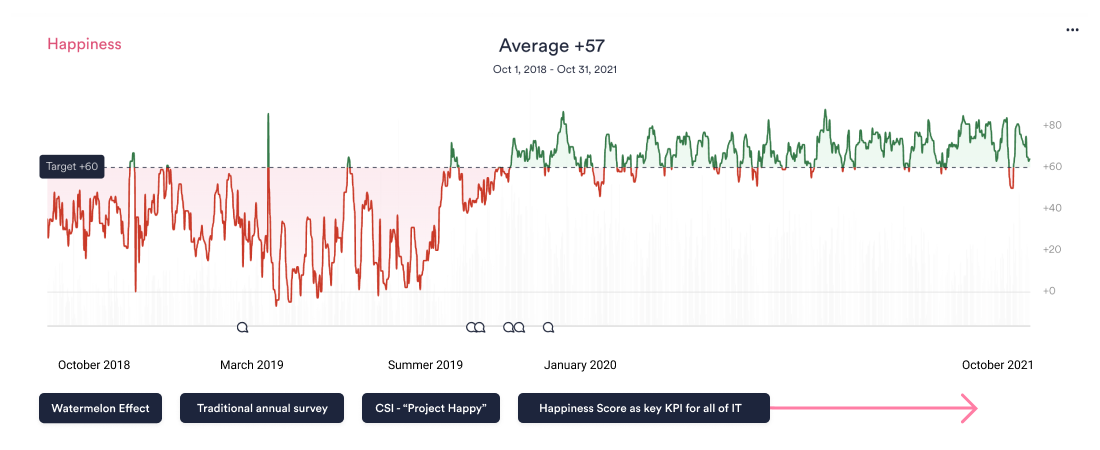There's a lot of 'talk' about experience level agreements (XLAs), but very little in terms of practical guidance for IT service managers and directors on how to successfully bring XLAs into your own organization. This is where that changes – this in-depth Practical Guide to XLAs provides actionable advice from how to get started, through to common mistakes to avoid.

.jpg)
In short, XLAs should focus on the measurement of outcomes and the value given by a service, instead of having judicial agreements on metrics – which is why we recommend you to take into practice IT Experience Management.
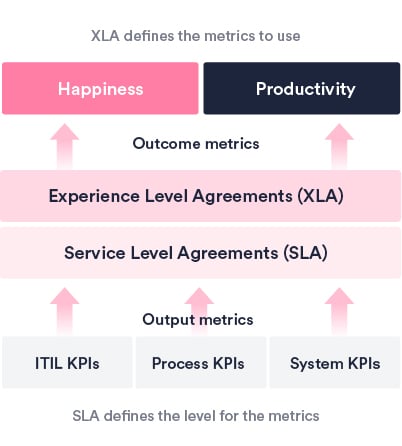
XLAs don’t have a universal formula that companies should follow. Instead, XLAs should be tailored to an organization’s IT problem areas, and the outcome and value they want to achieve.
To help show you what XLAs look like, we’ve drawn comparisons against its predecessor - SLAs.
| SLA - Service Level Agreement | XLA - Experience Level Agreement |
| Measures the output of IT. | Measures the outcome of IT. |
| Measures the processes. | Measures the added value and productivity of services. |
| SLAs focus on high level objectives, that can easily be met. However, they don't paint an in-depth picture of what is really happening within IT. | Brings focus directly to end-users' experience and needs. |
| SLAs show if IT is delivering projects within the right time frame and budget - ignoring the true success measure(s) of projects. | With XLAs you can bring business value and increase productivity of end-users. |
| Focus on sanctions. | Focus on rewards. |
| Measurement stays the same. | Measurement target levels constantly change. |
It's also worth mentioning that you can use XLAs and SLAs in tandem with each other, you don't have to simply rip and replace SLAs with XLAs. The important thing to note, however, is the need for the capabilities and metrics that measure success where outcomes occur and value is created.
There also needs to be the ability to adjust the target levels set in XLAs – which we cover in later chapters – due to business and end-user expectations constantly changing, as well as unprecedented phenomena occurring, which no one has no control over.
Both customers and service providers have compelling reasons to embrace XLAs and experience management. And it's no wonder why - XLAs offer a host of benefits that surpass traditional SLAs. XLAs and experience management are still new, and they are also a change to the IT organization. For these reasons, we recommend taking a step-by-step approach to both. Don’t try to jump from zero to a perfect world. Instead, a step-by-step approach will help guarantee that your organization gets quick results and the wider team behind the change to a more employee-centric way of working.
XLAs and experience management should be seen as an IT leadership tool - helping the IT organization to make better decisions and deliver more value to the business.
The main recommendations related to using XLAs in contractual agreements can be summarized as:
Discover invaluable insights on incorporating Experience Level Agreements (XLAs) into your IT supplier contracts from our white paper on How to Incorporate XLAs into Outsourcing Contracts, authored by Neil Keating from Bright Horse and Sami Kallio from HappySignals. Discover invaluable insights on incorporating Experience Level Agreements (XLAs) into your IT supplier contracts for an enhanced employee experience.
The benefits of XLAs differ greatly from the benefits you’ll be familiar with for SLAs. However, when adopting XLAs in your organization, some teams will struggle due to a variety of common mistakes.
Positioning SLAs this way creates no real direction for IT, won't create a positive change for end-users or service desk agents, or give you a true insight into your IT service experience.
Therefore, you also need to apply this to XLA positioning. Create a goal and meaning behind each XLA you design and define how it's going to add value to your end-users. Setting up an XLA just because industry experts (or this guide) say so, isn’t enough to do it. Discover what you want to solve or improve for an end-user with XLAs before you set them.
You can still use SLAs in conjunction with XLAs, however, make sure you're measuring the right things - i.e. XLAs to measure experiences and outcomes, SLAs to measure outputs.
Another common mistake is using a “one-size fits all” approach, similar to what has been found in SLA usage. XLAs need to be tailored to experience and an organization’s problems or needs. Furthermore, SLAs focus on what you can physically measure: time, budgets, tickets, etc. This completely misses the most important thing - the end-user’s experience.
Make sure that XLAs are measuring the most important and valuable outcomes instead of traditional operational data.
Another negative use of SLAs has been that they've remained the same, measuring the same outputs over time. This means they're rarely reviewed or updated to reflect changing business needs and priorities. With XLAs, you need to be continuously measuring your end-users experience and then updating your XLAs according to the received experience data. End-users’ experiences will change over time, therefore different goals and targets will need to be set in order to meet end-users’ needs.
It could even be said that the most important usage of XLAs or any experience-related measurement is to identify areas to improve. SLAs might help you to understand what is wrong with the process or service itself, but they can't be used to determine where the experience is lacking.
As already stated, experience level agreements are different to service level agreements. Even though only one word is different and it's still a three letter acronym, they're not the same and it's important to differentiate them.
HappySignals CEO Sami Kallio, differentiates the two as “SLAs measure the process, XLAs measure the outcomes and value.”
In order to differentiate XLAs from SLAs, as well as not to create confusion among your IT team, start to define what experience means within your organization.
Experience is not just an organizational change or new way of measuring, it’s a cultural change. We recommend reading up on organizational change management for maximum success in getting your end-users on board with XLAs.
Instantly swapping SLAs for XLAs is something we don’t advise. Yes, we’re pioneering for a change in measurement and experience, but we don’t recommend scrubbing out SLAs completely. In fact, our customers generally run both in tandem with each other.
Make sure you go through the necessary organizational change management process to introduce your end-users to this change. This is not an overnight procedure, therefore take time with the process, introductions, and transition to XLAs.
The biggest thing to adhere to, and something that has been mentioned above, is that XLAs are not a set-in-stone set of metrics that can be left here forever. You must adapt them, change them, and keep track of them.
Experience is a continuous evolution.
Now this is probably the biggest point for you to follow. Using XLAs without experience management misses the big picture.
As stated in the introduction – XLAs are just one piece of the puzzle. In order to understand the rest of the puzzle and to truly integrate XLAs you need to have experience management.
You may have already started to wonder how your XLAs can measure experience. Or how you find out what your end-users feel about your services. Perhaps how you can identify problem areas? Or even how you can gather actionable data around the impact XLAs will have on your IT services and processes for your end-users?

Businesses now have much higher needs and expectations of technology that IT providers must respond to. You only have to look to the global pandemic to see how quickly everything changed; IT and service departments were forced into rapid digital transformation in order to keep their organizations’ workforces active, let alone productive.
Furthermore, end-user wants and needs are also changing, with an increased demand for better and greater experiences with technology and services.
In many large-sized organizations, there is the belief that IT does not understand end-user needs, and simply just does “what it thinks is best.” To be able to serve businesses proactively, IT needs to understand the employees of its business. By doing this, IT can create and present improvements to the organization based on real end-user needs, as opposed to simply “gut feelings.”
So, how does this tie into experience management? In order to respond to business needs, deliver positive end-user experiences, and drive productivity and business value, you need to constantly monitor, manage, and maintain experience.
Experience management for IT consists of the measurement and sharing of experience data to identify key areas where experiences can be improved for end-users and external stakeholders, resulting in increased business value for an organization.
But let’s not “eat the elephant.” We’ve broken this down into bite sized chunks in an ITXM Framework to help you digest the concept more easily.
HappySignals brings you the process to manage experiences and set experience level targets.
Learn more about our IT Experience Management (ITXM™) Framework.
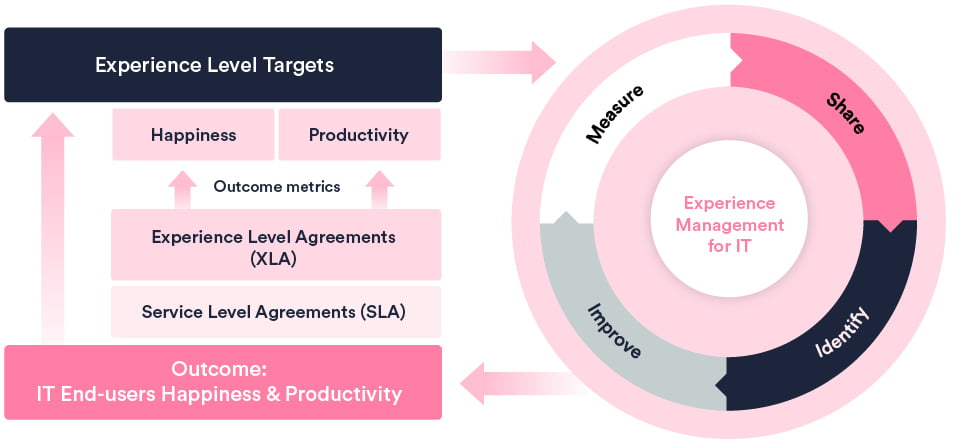
This section is where teams start on the ITXM™ Framework. The measurement delivers a baseline starting point for improvements and provides the data-driven insight needed to drive early positive change. This approach aligns with the ITIL 4 Guiding Principle of “start where you are.”
For measurement to be successful, the following elements need to be in place:
However, measuring doesn’t affect anything; it just shows the experiences end-users have today. But if your organization doesn’t measure experience and simply starts to make improvements, it won’t fully understand the current state and will act based on people’s gut feelings rather than data.
Without data-driven insights that highlight both the current issues and what matters most to end-users, any improvements will be chosen based on:
Instead, it’s important to recognize not only the need for experience data but also that experience is multi-dimensional. There’s, therefore, a need to be able to drill down into different areas of IT service delivery and support. For example, a country manager might need to see where their employees are losing productivity or a service owner the factors that contribute to the performance of their service(s), so they and their team can focus on the right improvement area(s).
Importantly, improvement needs to be about people, processes, and technology. Your organization probably already has great tools to run its technology and create the ITSM processes to support its IT operations. But how does it know what the outcomes are for end-users, i.e. the employees of your company (or the customer employees for MSP organizations)?
Better understanding the real issues your organization’s end-users face allows IT teams to quickly identify and address the possible process and technology factors that contribute to them. Your IT organization might have already known about some of the issues, maybe via a gut feeling, but now the real-time experience data shows what’s actually the case.
As your organization continues around the ITXM™ Framework cycle, it’s better able to prioritize what matters most and successfully deliver the changes necessary to improve the end-user experience and employee productivity, operations, and business outcomes. But these are not the only improvements – employee motivation and trust levels are also improved by sharing and celebrating successes.
Importantly, as an organization progresses around the cycle and the experience-measurement data starts to reflect the improvements made, IT personnel can see their work’s increasingly positive impact on end-users. This quantification of improvements allows the IT team to celebrate their work, feel motivated, and start on the next improvement challenge. Finding meaning in one’s work is a key factor for employee engagement, allowing IT leaders to elevate the performance of their teams and individuals further.
The communication of successes to business stakeholders is key, too – it increases the level of trust in IT capabilities and performance, and motivates end-users to continue to provide feedback knowing that it will benefit them through the improvement of IT service delivery and support.
When approaching digital transformation projects, your organization needs to start at the end first, figuring out what outcome is to be achieved. This outcome should be centered around your end-user needs and how it will bring value to them and the business.
Experience management is a vital part of reaching your organization’s desired outcome because it enables you to successfully approach digital transformation projects in three key ways:
As you now know, SLAs are not the right metric to measure experience. In order to successfully measure your end-user's experience and whether projects or services are delivered successfully, you need XLAs.
Through constant feedback loops, you can access high levels of real-time data relating to many areas of your end-users experience. This enables you to make data-driven decisions on where teams should focus their efforts to improve experience and create business value.
In order to embrace experience, there’s a need to adapt your culture to welcome and embrace change and new innovations and understand the reasons for digital transformation in the first place. This should be led by the IT department and not by individual business units. Culture is often a C-level initiative and, hence, we suggest you head over to our CIO Guide to Employee Experience Guide.
Another key part of reshaping your culture is introducing rewards for great results, not just having the sanctions that are commonly present with SLA metrics. By including rewards in your experience agreements you’ll motivate your service provider to deliver a great service.
| Role | Output focus (SLA) | Outcome focus (XLA) |
| CIO / IT directors / IT management team |
SLAs are needed to control what we and partners do. When they are green, we're doing well. |
I give focus and direction to my IT department and empower them to deliver good experience to our end-users. This is how we prove our value to business stakeholders and increase the productivity and happiness of our end-users. |
| Service owner for service management |
SLAs need to be met, because that is what my management team is looking for. |
I analyze the experience data together with my vendors and bring solutions to life that improve happiness and productivity. |
| Service owner for end-user services |
It's the service desk’s responsibility as to whether people are unhappy with the service. I just run the service based on uptime and availability. |
I monitor and analyze the experience of my end-users to make sure the service provides what they're expecting. They are my colleagues and I want them to be able to do their jobs productively. |
| Service owner for end-user devices |
I optimize the cost structure of our devices and make policies for them. A dollar saved is a dollar earned, right? |
I understand different end-users and their device needs. I try to save their time, which saves the company money and makes our workforce happier and more productive. |
| Service owner for service desk outsourcing |
I outsource to an external provider and make sure sanctions are in place if customer satisfaction scores (CSAT) are not at the level agreed two years ago. |
We add experience metrics into our contracts as XLAs, with rewards if they exceed the expectations of our end-users. I work with them to make sure this happens too. |
| Service desk managers |
I bring escalated cases to our team meetings and make sure the whole team meets the SLAs that are set. My concern is not the end-user.
|
I share all the experience data in real-time with everybody on the service desk, 75% of it is positive and I know that I make a positive impact on the motivation of my agents. Agent satisfaction correlates directly to the end-user experience and I can prove it with data. We can also talk with service owners about how their service is experienced, showing it isn’t totally the responsibility of the service desk. |
| IT department employees (including agents) |
I “keep the lights on” and systems running. I hate end-users complaining when they don’t understand that I can't help them. |
I come to work every day to provide the most productive IT solutions to our employees so that they can serve our external customers well. This makes me happy. |
| End-users - the employees of your company |
They just want to get rid of me. It's always my fault. |
They’re here for me and help me as a colleague. The feedback I give is appreciated and used to improve IT services. This makes me happy. |
MSPs have traditionally focused on delivering to agreed-on service levels. Where when a service level agreement (SLA) target is turning red, there’s a focus on remedying the situation. However, if an SLA is green, people won’t necessarily look at it – because they think the service is operating well. But just because an SLA target is green doesn’t mean that the customer, or the end-user, is happy with the service and the MSP. This disparity might be seen via people-centric metrics such as customer satisfaction (CSAT). But it might not.
Experience measurement and management and XLAs, on the other hand, allow MSPs to better understand what’s working well and what’s not (and to address the highlighted issues). This is because there’s an improved understanding of how end-users actually feel about the services they receive and the business impact of any issues. This insight allows an MSP to put the customer at the heart of delivering services and improving them.
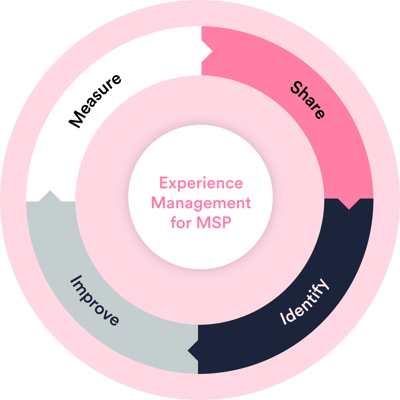 For years, traditional MSP SLAs have pushed the service providers to work – and think – in a certain way, but, at some point, most people eventually understand that there’s a conflict between the MSP and end-user view of service performance. Take CSAT questionnaire feedback as an example. The feedback requests tend to be delayed, there’s usually little response, and the questions asked might be removed from what’s actually important to end-users. Ultimately, the CSAT data offers a limited and perhaps skewed view of what end-users think of their MSP’s performance.
For years, traditional MSP SLAs have pushed the service providers to work – and think – in a certain way, but, at some point, most people eventually understand that there’s a conflict between the MSP and end-user view of service performance. Take CSAT questionnaire feedback as an example. The feedback requests tend to be delayed, there’s usually little response, and the questions asked might be removed from what’s actually important to end-users. Ultimately, the CSAT data offers a limited and perhaps skewed view of what end-users think of their MSP’s performance.
For MSPs to really understand their customers’ issues and challenges, they instead need to provide end-users with the opportunity to submit real-time feedback on services based on what matters most to them. This capture of experience data, in high volumes, allows an MSP to see where and why there’s unhappiness or a poor end-user experience with certain services or products they’re providing.
It might, for instance, identify that a new or revised process brought in to help the service provider has caused end-user issues with the service and experience degrading as a result. For example, there’s now a lack of contact or the end-user is asked the same question multiple times. However, despite the issues, the SLA target could still be met, and the MSP views the service as good while the end-user experience is poor and the customer’s – or customers’ – employees are unhappy.
With experience management, MSPs can work together with their customers – using more and better data to have a common understanding of how well services are delivered. This insight identifies the priority issues to tackle, and the MSP can apply corrective measures more quickly (with the affected end-users seeing the services they use getting better through the changes the MSP applies).
Importantly, these improvements don’t stop with a single customer’s issues – because MSPs provide services to multiple customers, relevant learnings and improvements can also be applied to other customers. The issue could again be a process or a particular way of working that’s causing end-users problems no matter the customer, and instead of changing it for just one customer it can be changed for the others too.

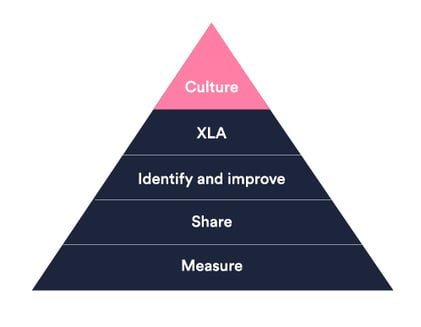
Experience management should become the centerpiece of any IT culture, however, getting there is not an overnight process.
We’ve created a way for IT to start adopting an experience management mindset today. Following the concepts of Maslow’s Hierarchy of Needs, we’ve created the experience management pyramid. In order to successfully achieve an experience management culture, your organization must transition through each stage in order.The first level of the pyramid begins with continuous measurement, something that has been reiterated throughout this document. Continuous measurement is the foundation of experience management because, without it, there’s no suitable data from which to gain actionable insights. In this step, your end-users give continuous feedback on the services they receive. You may be thinking “Oh great, a load of negative feedback,” but we‘ve found that on average 75% of feedback is positive.
Experience data should not be owned by one person – it's important to share it between your teams, employees, and partners. This creates transparency of any issues and makes it everyone’s job to improve by creating combined goals to reach together.
From the collected experience data – now that teams and partners are aligned – it’s time to set targets based on the outcomes you want to achieve. Following the advice given above, make sure you set targets that are focused on your end-users and their experiences, as well as the value that these targets, when met, will bring to your end-users.
As mentioned earlier, the key is to start by measuring the experience data, and the sooner your organization can start measuring the better. In addition, sharing your experience data with the whole of your IT department and partners allows smart people to start making data-driven decisions. So make sure all stakeholders can easily access the data. Once the first two steps are done you can start to identify the challenges you might have.
Below we've outlined our experience management process, to show you the necessary steps to happiness, and essentially an experience-driven IT culture. Next up, we’ll walk you through the process of measuring and sharing experience data as well as setting XLAs.

Customer satisfaction is often confused with customer experience because they sound very similar. There are, however, key differences between the two.
In short, CSAT measures the transaction that happened and how satisfied an end-user was with the interaction between them and the service provider. So you could be satisfied with the service you got, but not the end result of that service or how you initiated it. Experience metrics measure the end-to-end experience, everything that happened before, during, and after.
Traditionally, experience in IT has been measured via a once-a-year survey or through random surveys after some tickets have been handled by the service desk.
The issue with a once-a-year survey is that they’re very generic and they don’t react in the same speed that the world does (you only have to look at the global pandemic to see that). Generic survey questions also mean that you’re potentially asking end-users to rate something they've no experience with. For example, perhaps they don’t use a particular service that is mentioned in, say, question 36.
A better way is to have focused audiences and ask for regular, daily feedback from a small group of end-users. This way you’ll get a continuous stream of responses and see the effect of changes made instantly. For example, having a big enterprise resource planning (ERP) project for multiple years, rolling out to one location at a time, would allow you to learn as you go and improve the experience after each rollout.
You need to measure all aspects of IT, not just the IT service desk. This means topics like devices, enterprise applications, remote working, the office environment, support services, and so on. Each measurement will have its own consumer in the IT department. It’s also likely the IT management team and CIO will want to see them presented in one view or report.
Companies can start with a small selection of topics and then expand to more topics as they start to learn the new ways of thinking about service development.
In order to set goals for IT, we need to be able to measure and manage the targets we set. That is why you can set targets in HappySignals.
Basically, after setting targets, you’re highlighting all aspects of the end-users’ experiences in all the views you see in HappySignals.
Sharing the targets is important, which is why you can use the live screens (our digital signage tool) to display the real-time tracking you have in your office or remote locations.
Experience level targets should be reviewed regularly because end-user expectations change over time. These targets are inputs for your continuous improvement process, or even for your DevOps process.
Find out how to implement XLAs in practice:
When using a real-time analytics tool, like HappySignals, you can instantly understand that experience is multidimensional. Meaning that depending on the person who looks at the data, they need to be able to drill-down based on the data they’re responsible for.
For example, a country manager will click on a specific country to see how the experience is with different services, channels, or assignment groups. But a service owner for email services will just click on “Office365” and see how it’s being experienced in different locations, by different business units, and so on.
IT management teams should treat experience data as the business intelligence (BI) data they use to run their operations. Just like in sales, the sales dashboard is regularly looked at to lead and manage the sales team, this is the equivalent tool for modern CIOs.
Listen to how the CIO of Campari Group describes the importance of this.
Taking experience management seriously will lead to tangible results and change your IT culture. On average, HappySignals customers have been able to make a 26% improvement in productivity, when the first two months of measurement are compared to the last two months of their experience management journey.
Basically, these companies are focusing solely on the happiness of end-users, which has brought them alignment and huge returns in end-user productivity.
But enough from us, we’ve gathered an excellent list of customer cases so you can learn from real-world examples.
Below we've collected some real-life case studies that show practical examples of how XLAs are being used by some of the industry pioneers in IT Experience Management and XLAs.
